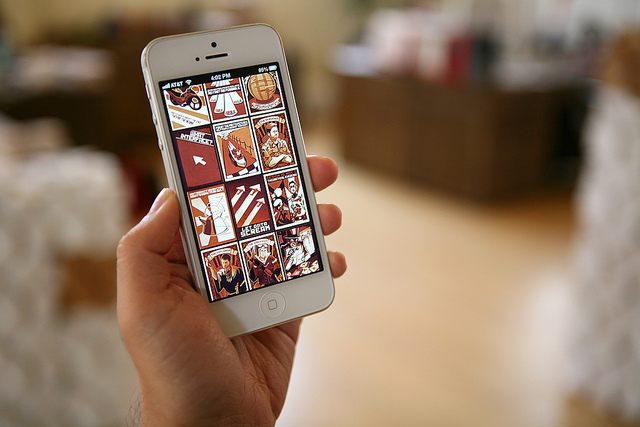To create user interfaces that really capture the attention of users it is important that you pay attention to details.
One of the details that maybe doesn’t seem worth spending time on but definitely is worth rolling up your sleeves and digging into is micro-interactions. Micro-interactions are the little actions that happen before, during, and after a user engages with a website or mobile app and should be a part of your website or mobile app development process.
Micro-interactions help guide users when they are using your interface by offering noticeable responses to behaviors confirming that the system has received their input. To summarize a micro-interaction, when a user takes an action, the interface responds in a pleasing way that engages the user.
Use micro-interactions to improve user engagement
Well thought out micro-interactions improve user engagement on websites, mobile apps and other products.
Take the time to consider the experience a person has with your website or mobile app, what do they see, feel and think while utilizing your user interface? Is it a joy to use? Are they excited? Do they want to tell their friends about it?
Often nuances such as micro-interactions are overlooked in the rush to get your website or mobile app live. But if you think about it, the user interfaces that you really enjoy using and that you tell your friends about are the ones where somebody took the time to sweat the small stuff.
Have you ever been on a mobile app or web site and thought to yourself “Wow! That is cool” when you were surprised by an unexpected detail? These are the kind of things that make an interface a joy to use and keep users coming back.
If you are not familiar with micro-interactions, here are a few basic examples that you might be familiar with:
Usability
Usability is one of the key factors of great interface design. Great usability often includes micro-interactions. Micro-interactions encourage engagement and help users understand how an interface works.
These small details may seem insignificant, but from a user experience standpoint, they genuinely make a huge difference between an interface that is just ok and an interface that is exceptional. These micro-interactions help the user feel rewarded for taking an action and can help teach them how to use the interface in a pleasant way.
Image: Fouquier (Flikr) http://bit.ly/2QVLFUF
The only way to make a mobile app or website user-centered is to focus on the user early and throughout the design process. You must consider the application’s target users during several key points during design.
Validating your design is one of the most critical points of the process. Usability testing is an industry standard for validating websites and mobile applications along with other types of software. Companies that leverage usability testing are generally benefited by the process and are able to utilize the knowledge they gain to make their products more user-friendly.

Usability testing during early stages can produce big results without having to expend a great deal of cost to make alterations.
Keep in mind that you should not wait until the end of the design process to start doing usability testing. In the early stages of design it is easy to edit and change your design so testing during early stages can produce big results without having to expend a great deal of cost to make alterations.
Plan your test
Before getting started, you should carefully plan what you want to test. Determine which assumptions you want to validate, how many people you will have participate in the test, where you will conduct the test, etc. The more carefully you plan all these items, the more effective your testing will be.
Start by determining what it is you will be measuring.
Consider that there are two types of metrics to measure, qualitative and quantitative. Both can give you valuable information. Quantitative metric includes data such as time taken on complete a task, number of clicks, etc. You can think of quantitative metrics as factual data generally based on time or numbers. Qualitative data is much different in that it tends to be allegorical evidence based on users’ satisfaction and or their impression of a design or process.
Generally, usability testing will focus heavily on the qualitative information but don’t forget that you will need the quantitative information that will allow you to base decisions on facts.
What is the objective of your plan? Once you determine what you will be testing you need to put together a plan for how you will be testing it. What is the process? How will you best be able to gather the information that will be useful in making decisions?
Who will you include in your testing? You have to be careful that the people you test match the personas of future users to be able to gather relevant data.
Performing the test
Testing can be of any duration, but we have found testing periods under a half hour are responded to most favorably by test subjects. Make sure you are not frustrating the test subjects by using up too much of their time.
While working with your test subject, make sure they feel comfortable. Interact with them in a friendly way. We generally do this by informing them that we are not testing them but testing our design, this takes the pressure off them and frees them up to give you useful information.
How you moderate the test is important. Be careful not to guide or bias the user. When you are conducting the usability test you are an observer who should not impact results. Pay attention to the test subject. We typically ask to share their thoughts throughout the process, giving us great insight into how they view the solution to tasks. If a certain design is cumbersome or confusing, you want them to let you know so you can correct it.
Take the time to carefully observe them completing tasks. If they have a hard time completing a task it lets you know that your design needs additional work to streamline the process.
Analyze and report
Once you have completed your testing it is time to analyze the data and arrive at conclusions.
Approach this phase with a keen eye on usability. Don’t think like a designer and don’t focus on the design, rather, approach this part by looking at the user’s goals. Were they satisfied? Did they have an easy time completing tasks? Did you give them what they wanted? Be empathetic towards your user and their needs.
Make sure you have noted metrics such as success rate, user satisfaction and user frustration for the various tasks so you are able to figure out where design changes are necessary. In your report, make sure you prioritize the findings. Focus on observed behavior and not what you think.
Keep your report short, avoiding overly long descriptions. Make sure you include positive findings as well as areas that need to be adjusted. Include the feelings of your test subjects and don’t focus solely on negative comments, only pointing out flaws.
Concrete quantitative data, along with qualitative data, will make your report more effective. The why will add a great deal to your analysis. Make sure you include quotes from your test subjects.
Image: Jan-Willem Reusink (Flikr) http://bit.ly/2OP8GIm
The days of design just for the sake of design seem to be long since gone when it comes to digital media.
Digital designers now days focus on human interaction. This change has designers looking at use rather than simply creating designs.
 Usability is where advantage lies in today’s marketplace.
Usability is where advantage lies in today’s marketplace.
A UI | UX design company with top digital designers will bury themselves in the world of customers. They look at projects from the customer’s point of view and create user interfaces to meet their needs as intuitively as possible. These firms check ego at the door and concentrate on how things are used.
As Steve Jobs famously stated, “Design is not just what it looks like and feels like. Design is how it works.”
Looking forward, mobile and digital design will be grounded in a customer centric approach, focusing on use in a way to empower consumers. More and more businesses will see the success of those focusing on the user experience and follow their lead.
But keep in mind it isn’t just a design trend that is propelling customer centric design. Consumers are becoming progressively less patient, if web sites and mobile apps are not immediately easy to use, a customer will not take the time to learn how to use it and a sales opportunity may be lost. It is essential in the modern marketplace to provide tools that are easy to use.
Companies that have taken the plunge and focus on design have outperformed the S&P 500 by 219 percent between 2004 and 2014 (Design Management Institute). Clearly a focus on design pays off.
One of the hottest trends within the world of user experience design is Contextual UX.
Contextual UX allows a system to adaptive to the needs of a user. Contextual UX also allows for a system to integrate situational context. A great example of contextual UX are the ‘Recommendations for you” sections on Amazon.com or the sections called “Inspired by your browsing history”. Amazon is delivering content based on the individual needs of each user.
By balancing effective customer centric design with personalized content delivery the needs of the customer are addressed to increase interaction and improve the experience for each user.
Photo: Juhan Sonin (Flikr) http://bit.ly/1LyEomI